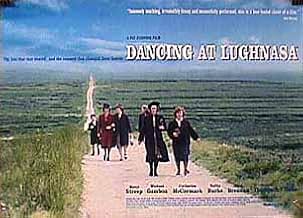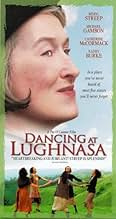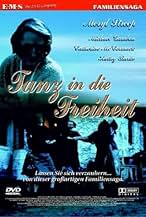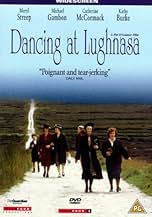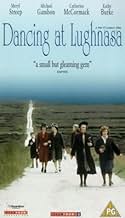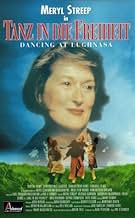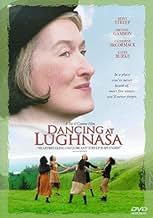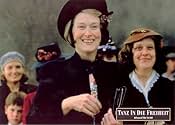IMDb-BEWERTUNG
6,3/10
4328
IHRE BEWERTUNG
Schauspielerisch brillantes Drama um fünf irische Schwestern und den Bruch ihrer intakten Familie im ländlichen Irland des Jahres 1936.Schauspielerisch brillantes Drama um fünf irische Schwestern und den Bruch ihrer intakten Familie im ländlichen Irland des Jahres 1936.Schauspielerisch brillantes Drama um fünf irische Schwestern und den Bruch ihrer intakten Familie im ländlichen Irland des Jahres 1936.
- Regie
- Drehbuch
- Hauptbesetzung
- Auszeichnungen
- 2 Gewinne & 7 Nominierungen insgesamt
Gerard McSorley
- Narration by
- (Synchronisation)
Empfohlene Bewertungen
This movie version is pleasant enough but does not have the power of the stage play upon which it is based. Spoilt brat that I am, I saw the original production at the RNT in 1990 with the amazing Alec McCowen as Uncle Jack. I am a great fan of Michael Gambon, but he is simply miscast in that role for the movie. Not so Meryl Streep, who does a superb overpowering aunt. The delightful Catherine McCormack and Rhys Ifans do a good job of the love interest. This is nevertheless a shadow of the stage play. My better half liked it, but had not seen the stage version. For lovers of Irish drama the film is worth 90 minutes of your time.
The acclaimed stage play from Brian Friel has been successfully adapted for the screen in this visual treat from Pat O'Connor. The beautiful landscapes of Donegal do not smother the intelligent performances such as from Meryl Streep (Kate Mundy), Catherine McCormack (Christine Mundy) and Rhys Ifans (Gerry Evans). Those critics who have condemned the movie for being simple and about ordinary people seem to miss the point. This is meant to be a simple story about ordinary people - and that is why it is so moving! More importantly though - 'Dancing at Lughnasa' is also entertaining and really deserved better than the mixed reviews on initial release.
I wasn't really sure what to expect from this movie, since I had no idea what the play was about or anything. The only actor in the movie I had heard of was Meryl Streep, but that didn't matter because she was the reason I went to see the movie. As always, her accent was pitch perfect, right down to the Donegal vowels. Her performance was also incredible, which deserves some recognition but probably won't get any. The rest of the cast was also wonderful, particularly Sophie Thompson as Rose. If anyone else should get recognition, it should be her because her performance was heart-wrenching and bittersweet. So GO AND SEE IT!!! NOW!!
Given the luxury of owning films via DVD collections offers the opportunity to revisit at will the works the viewer found worthy of purchase. Such is the case with the luminous 'Dancing at Lughnasa', a 1998 release by director Pat O'Connor to the tunes of a lilting screenplay by Frank McGuinness based on Brian Friel's 1990 play of the same name. Though low key and not a popular hit at the box office, this is one of those rare films that combines a very simple tale about common folks brought to life by a cast of extraordinary actors.
The story is set in Donnegal, Ireland in 1936 (just before WW II)choked the world) and simply relates the life of a family of five single sisters and the love child of one of them. The action is spare, centering on the visit of their brother home from the missionary work in Uganda inalterably changed from the experience, on the loss of job of the supporting eldest sister, and the return of the errant father of the love child for the summer, and other daily challenges. The stresses and strains these small events play on the sisters is eventually climaxed in the dancing festival that marks the Feast of Lughnasa (a persistent pagan celebration that challenges the very Catholic foundation of the Irish community), a compelling event that parallels the returned priest brother from the mission fields where he has gained insight into the desperate need for community, happiness, dancing and celebration as the essential needs of humankind.
The cast is flawless: Meryl Streep is superb as the elder sister bitterly bound to holding the family together at all costs, Catherine McCormack as the mother of the lovechild, Kathy Burke, Sophie Thompson and Brid Brennan; Michael Gambon as the deranged returned brother; and Rhys Ifans as the errant father of the child. They interact and play like fine chamber music. The brilliantly green and gorgeous countryside is captured eloquently by Kenneth MacMillan. In every aspect of production the film fits like a tightly intertwined puzzle. It simply glows. Revisiting 'Dancing at Lughnasa' is an even finer trip than the first exposure. Highly Recommended.
The story is set in Donnegal, Ireland in 1936 (just before WW II)choked the world) and simply relates the life of a family of five single sisters and the love child of one of them. The action is spare, centering on the visit of their brother home from the missionary work in Uganda inalterably changed from the experience, on the loss of job of the supporting eldest sister, and the return of the errant father of the love child for the summer, and other daily challenges. The stresses and strains these small events play on the sisters is eventually climaxed in the dancing festival that marks the Feast of Lughnasa (a persistent pagan celebration that challenges the very Catholic foundation of the Irish community), a compelling event that parallels the returned priest brother from the mission fields where he has gained insight into the desperate need for community, happiness, dancing and celebration as the essential needs of humankind.
The cast is flawless: Meryl Streep is superb as the elder sister bitterly bound to holding the family together at all costs, Catherine McCormack as the mother of the lovechild, Kathy Burke, Sophie Thompson and Brid Brennan; Michael Gambon as the deranged returned brother; and Rhys Ifans as the errant father of the child. They interact and play like fine chamber music. The brilliantly green and gorgeous countryside is captured eloquently by Kenneth MacMillan. In every aspect of production the film fits like a tightly intertwined puzzle. It simply glows. Revisiting 'Dancing at Lughnasa' is an even finer trip than the first exposure. Highly Recommended.
What distinguishes stage from screen? If a viewer had only Brian Friel's play, `Dancing at Lughnasa' and its cinematic adaptation to judge from, he or she might be tempted to answer that, while stage is highly engaging and meaningful, screen is superficial, insulting, and thin in content. Friel's play is structured in such a way that a film version necessarily provides a fascinating comparison of the two mediums. However, director Pat O'Connor's efforts tend to demonstrate the weaknesses of cinema rather than the strengths. Adapting a play to the screen has often proved to be a tricky business; it involves some pitfalls which this film does not manage to avoid.
Screen is extremely literal. It allows for--in fact, often demands-- a sense of realism seldom conveyed on stage. The makers of `Dancing at Lughnasa' are clearly appreciative of this fact, and have made valiant, if not always successful, allowances for it. The primary result of their efforts is a heightened sense of setting. The world these characters inhabit feels real. We get shot after shot of Irish countryside; set and costume design seem perfect for Ireland in the 1930s. Mark Geraghty's production design is one of the best things about this film. Additionally, excellent accent work by all the actors proves perfectly convincing and adds depth to the setting.
However, such a literal medium has its drawbacks. In particular, young Michael's narration, which was used to achieve a specific effect in the play, seems unnecessary here. The play's Michael is full-grown and speaks young Michael's lines as his `memories' take place in the action on stage. The film makers did well to recognize that there was no cinematic equivalent for this; having the adult narrator speak the child's lines would have seemed ridiculous. However, in removing that aspect of the narrator's role, they stripped away most of his significance, as well. The film's narrator seems like an afterthought, occasionally intruding into the action to tell us that what we are seeing is a memory. We could easily forget that the events are, in fact, happening in flashback.
While some of the abstract elements of Friel's original play do not translate well onto the screen, individual performances are only aided by the medium. Since film is not hindered by the simple vocal requirements of stage, the actors are able to convey much more subtlety of meaning. The players in this film version are, without exception, excellent. Meryl Streep stands out as the proper, reserved Kate. Her manner is nervous and slightly shrill, but conveys genuine concern for her sisters. When Kate opens up and allows herself to dance, Streep shows a joyful abandon which is believable and pleasant to see. Another standout performance is delivered by Michael Gambon in the role of Father Jack. His lines are spoken with calm assurance, betraying Jack's senility only by their complete lack of relevance. Gambon's distant eyes and quiet detachment reinforce the feeling that he exists in a world entirely different from the rest of the family, a point which is absolutely crucial to his character. Supporting characters are also portrayed dead-on. This film has some of the best acting that could have been hoped for.
Despite these considerable advantages, the movie runs into trouble when it tries to adapt Friel's plot to the screen. Film is so much more visual than theater that it demands a great deal of variation in order to keep the viewer interested. Since we do not have the benefit of the actors' physical presence, we need other things to hold our attention. In attempting to add variety to the play's structure, screenwriter Frank McGuinness breaks up Friel's original dialogue into smaller scenes, most of which involve household chores. McGuinness also tries to represent some events which the play's dialogue only alludes to. The result is a film which is so fragmented that we lose sight its content. Friel's dialogue is integrally important to his play, and the same is true for the film. However, the way that the film breaks up this dialogue among tiny scenes is extremely distracting. We lose sight not only of the dialogue's meaning, but of the relationships between characters. Since the adapted structure requires that the five sisters rarely appear in the same scene together, it is very difficult to get any sense of the dynamic in the household. Ultimately, so much time is spent with action rather than dialogue that the characters lose a great deal of their depth. Perhaps film makers did not trust their audience to be as interested in the characters as in the events.
It is somewhat unjust to evaluate an adapted play simply in light of the original. However, this cinematic version fails to hold up even on its own terms. It is difficult to conceive what value those who have not been exposed to the original play could see in this adaptation. What we get is a good-looking, but ultimately insubstantial, portrait of five women who could all stand to let their hair down a little bit more than they do. I can't help but think that Friel had more in mind than demonstrating the value of letting one's hair down.
Screen is extremely literal. It allows for--in fact, often demands-- a sense of realism seldom conveyed on stage. The makers of `Dancing at Lughnasa' are clearly appreciative of this fact, and have made valiant, if not always successful, allowances for it. The primary result of their efforts is a heightened sense of setting. The world these characters inhabit feels real. We get shot after shot of Irish countryside; set and costume design seem perfect for Ireland in the 1930s. Mark Geraghty's production design is one of the best things about this film. Additionally, excellent accent work by all the actors proves perfectly convincing and adds depth to the setting.
However, such a literal medium has its drawbacks. In particular, young Michael's narration, which was used to achieve a specific effect in the play, seems unnecessary here. The play's Michael is full-grown and speaks young Michael's lines as his `memories' take place in the action on stage. The film makers did well to recognize that there was no cinematic equivalent for this; having the adult narrator speak the child's lines would have seemed ridiculous. However, in removing that aspect of the narrator's role, they stripped away most of his significance, as well. The film's narrator seems like an afterthought, occasionally intruding into the action to tell us that what we are seeing is a memory. We could easily forget that the events are, in fact, happening in flashback.
While some of the abstract elements of Friel's original play do not translate well onto the screen, individual performances are only aided by the medium. Since film is not hindered by the simple vocal requirements of stage, the actors are able to convey much more subtlety of meaning. The players in this film version are, without exception, excellent. Meryl Streep stands out as the proper, reserved Kate. Her manner is nervous and slightly shrill, but conveys genuine concern for her sisters. When Kate opens up and allows herself to dance, Streep shows a joyful abandon which is believable and pleasant to see. Another standout performance is delivered by Michael Gambon in the role of Father Jack. His lines are spoken with calm assurance, betraying Jack's senility only by their complete lack of relevance. Gambon's distant eyes and quiet detachment reinforce the feeling that he exists in a world entirely different from the rest of the family, a point which is absolutely crucial to his character. Supporting characters are also portrayed dead-on. This film has some of the best acting that could have been hoped for.
Despite these considerable advantages, the movie runs into trouble when it tries to adapt Friel's plot to the screen. Film is so much more visual than theater that it demands a great deal of variation in order to keep the viewer interested. Since we do not have the benefit of the actors' physical presence, we need other things to hold our attention. In attempting to add variety to the play's structure, screenwriter Frank McGuinness breaks up Friel's original dialogue into smaller scenes, most of which involve household chores. McGuinness also tries to represent some events which the play's dialogue only alludes to. The result is a film which is so fragmented that we lose sight its content. Friel's dialogue is integrally important to his play, and the same is true for the film. However, the way that the film breaks up this dialogue among tiny scenes is extremely distracting. We lose sight not only of the dialogue's meaning, but of the relationships between characters. Since the adapted structure requires that the five sisters rarely appear in the same scene together, it is very difficult to get any sense of the dynamic in the household. Ultimately, so much time is spent with action rather than dialogue that the characters lose a great deal of their depth. Perhaps film makers did not trust their audience to be as interested in the characters as in the events.
It is somewhat unjust to evaluate an adapted play simply in light of the original. However, this cinematic version fails to hold up even on its own terms. It is difficult to conceive what value those who have not been exposed to the original play could see in this adaptation. What we get is a good-looking, but ultimately insubstantial, portrait of five women who could all stand to let their hair down a little bit more than they do. I can't help but think that Friel had more in mind than demonstrating the value of letting one's hair down.
Wusstest du schon
- WissenswertesOriginal choices to star were Frances McDormand and Kate Winslet.
- PatzerThe radio is one of the first ever made, so it's a tube radio, which would not be able to come on instantly like the later transistor radios; it would have needed a while to warm up before there would be any sound from it.
- Zitate
Kate 'Kit' Mundy: I am a righteous bitch, amn't I?
- Crazy CreditsDuring the opening credits, stills of African tribal dances and of Jack as priest in Africa are shown.
Top-Auswahl
Melde dich zum Bewerten an und greife auf die Watchlist für personalisierte Empfehlungen zu.
- How long is Dancing at Lughnasa?Powered by Alexa
- What is 'Dancing at Lughnasa' about?
- Is this film based on a book?
- What is "Lughnasa"?
Details
- Erscheinungsdatum
- Herkunftsländer
- Offizieller Standort
- Sprache
- Auch bekannt als
- Strange Darling
- Drehorte
- Produktionsfirmen
- Weitere beteiligte Unternehmen bei IMDbPro anzeigen
Box Office
- Bruttoertrag in den USA und Kanada
- 2.287.818 $
- Eröffnungswochenende in den USA und in Kanada
- 83.759 $
- 15. Nov. 1998
- Weltweiter Bruttoertrag
- 2.287.818 $
- Laufzeit1 Stunde 35 Minuten
- Farbe
- Sound-Mix
- Seitenverhältnis
- 1.85 : 1
Zu dieser Seite beitragen
Bearbeitung vorschlagen oder fehlenden Inhalt hinzufügen

Oberste Lücke
By what name was Tanz in die Freiheit (1998) officially released in India in English?
Antwort


